If there’s one thing we can be thankful for when it comes to the banking crisis, it’s this: at least it means fewer headlines about Fed rate hikes!
That’s actually a good thing for us, because, as the Fed statement hinted on Wednesday, the Fed is getting set to finally pivot. It’s the moment everyone has been waiting for all along! And it feels like almost no one is paying attention.
But we contrarian dividend investors are. And there are a couple of closed-end funds (CEFs) out there that are well-positioned to profit from the Fed’s quiet shift: the Nuveen S&P 500 Dynamic Overwrite Fund (SPXX) and the Nuveen Nasdaq 100 Dynamic Overwrite Fund (QQQX), which yield 7.8% and 7.3% respectively.
The nice thing about this duo is that besides tracking the major indexes (the S&P 500 and NASDAQ) they give us those high dividends by selling call options on their portfolios—a strategy that does particularly well when volatility spikes up.
And the underlying truth here is that, yes, it’s a bullish sign that the banking crisis has made the Fed less of an issue. Here’s why.
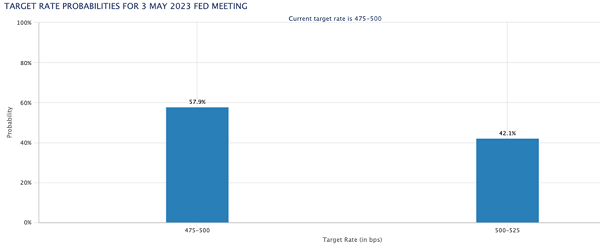
Source: CME Group
Last year’s bear market priced in all of the rate hikes we saw both last year and in 2023, so a few weeks back, when markets recently thought it likelier that the Fed would raise by 50 basis points at last Wednesday’s meeting, stocks didn’t move—everyone was too busy focusing on the failing regional specialty banks.
However, the Fed has also signaled it will pivot from higher rates in the future. The question is when. Now, futures markets are calling for the first rate cut to come in July, just two meetings from now:
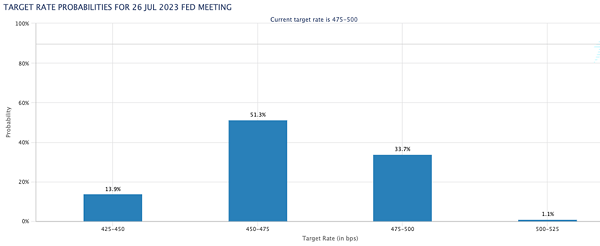
Source: CME Group
Whether the cut comes then or later, getting the timing wrong by a few months is not a big deal in the grand scheme—which is why (beyond the fact that the regional-bank situation has knocked the Fed out of the headlines) the exact timing of the Fed’s pivot has also become a bit less important recently.
How to Play the Shift Toward Lower Rates
SPXX and QQQX are sound choices in this environment, the latter being an even more aggressive play on priced-in Fed rate hikes, due to its focus on the tech-heavy NASDAQ. Meantime, both funds offer us call-option income to profit from volatility.
Now let’s take a look at their recent performance, which gives us a big hint on each fund’s valuation. Despite having income streams five times that of their index-fund peers, these CEFs are both more or less tracking their indexes, as you can see in the chart below.
Bigger Income and Solid Growth
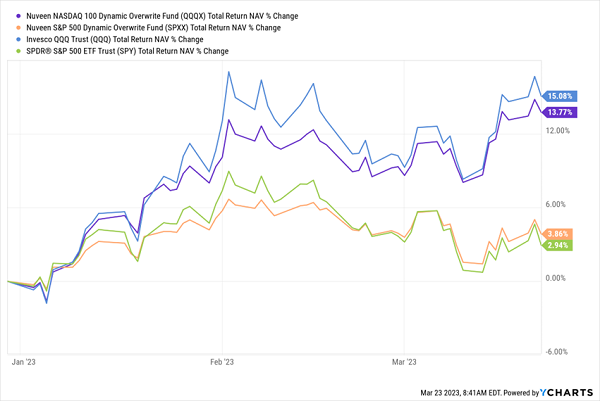
Note that this is total NAV return, meaning the profits that managers are earning by investing in the market. And you’d expect them to perform as they are, since these CEFs track the NASDAQ and S&P 500. But CEFs are different—which is why their market-price returns haven’t necessarily kept up.
QQQX’s Market Price Tracks Its NAV …
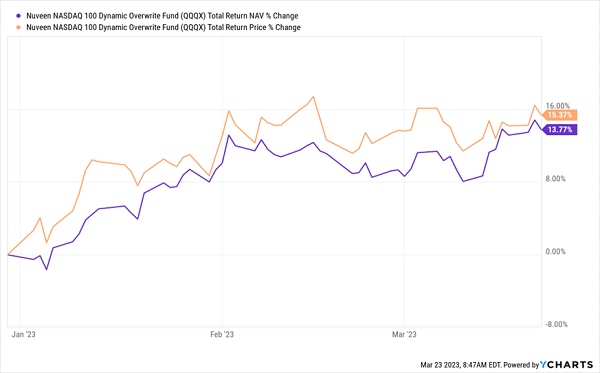
As you can see above, QQQX’s market-price return is pretty close to its NAV, which translates into a 5.8% premium to NAV as of this writing. But SPXX is a different story:
… But SPXX Is a Bargain
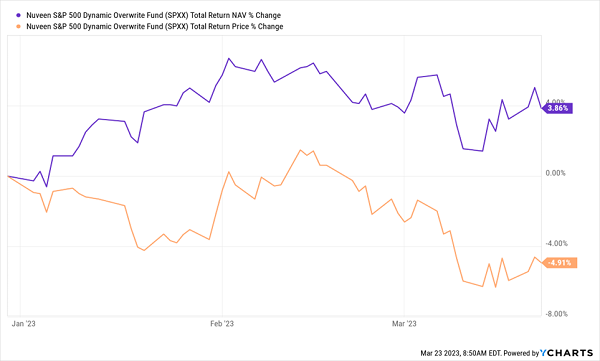
As you can see, SPXX is actually down on a market-return basis. This has brought SPXX’s premium to NAV, which was over 8% at the start of the year, down to a bit less than par. That’s a clear buying opportunity to play on later buy-in from CEF investors. Plus you get SPXX’s 7.8% income stream while you wait for that to happen.
Of the two, I’d lean toward QQQX now, however. The fact that its market price and NAV returns are similar for 2023 tells us that CEF investors are likely rotating assets out of the lower-risk SPXX and into the more aggressive QQQX.
This also suggests that investors think tech is more oversold than the broader market, and the broader market’s exposure to banks is a good reason to pivot. For that reason I expect more movement into QQQX over the medium term.
Buy These 5 CEFs Now for Steady 9.1% Dividends (While They’re Cheap!)
My top 5 CEFs for 2023 yield more than SPXX and QQQX (9.1% as I write this), but they have a key advantage: much deeper discounts!
In fact, their discounts are so far beyond the ordinary, I’m calling for 20%+ price upside in the next 12 months, to go along with their 9.1% yields.
That’s a combined potential return of 29.5%! AND you get even more diversification than the three funds above give you, for an extra margin of safety.
Click here and I’ll share my full CEF-investing strategy and show you how to claim your copy of an exclusive Special Report revealing these 5 funds’ names, tickers, current yields, best buy prices and more.
Before you make your next trade, you'll want to hear this.
MarketBeat keeps track of Wall Street's top-rated and best performing research analysts and the stocks they recommend to their clients on a daily basis.
Our team has identified the five stocks that top analysts are quietly whispering to their clients to buy now before the broader market catches on... and none of the big name stocks were on the list.
They believe these five stocks are the five best companies for investors to buy now...
See The Five Stocks Here
Enter your email address and we'll send you MarketBeat's list of seven stocks and why their long-term outlooks are very promising.
Get This Free Report